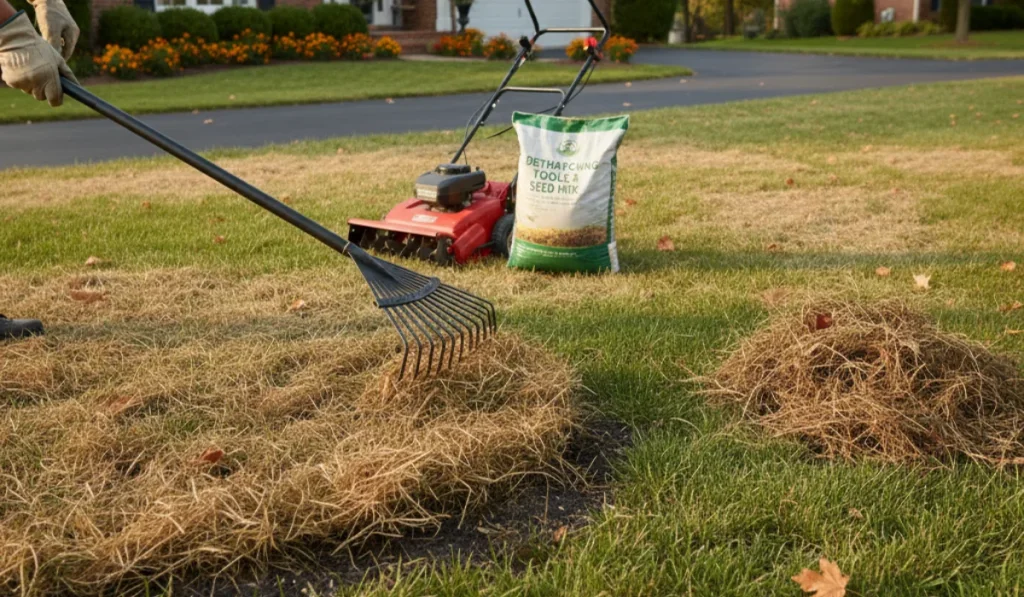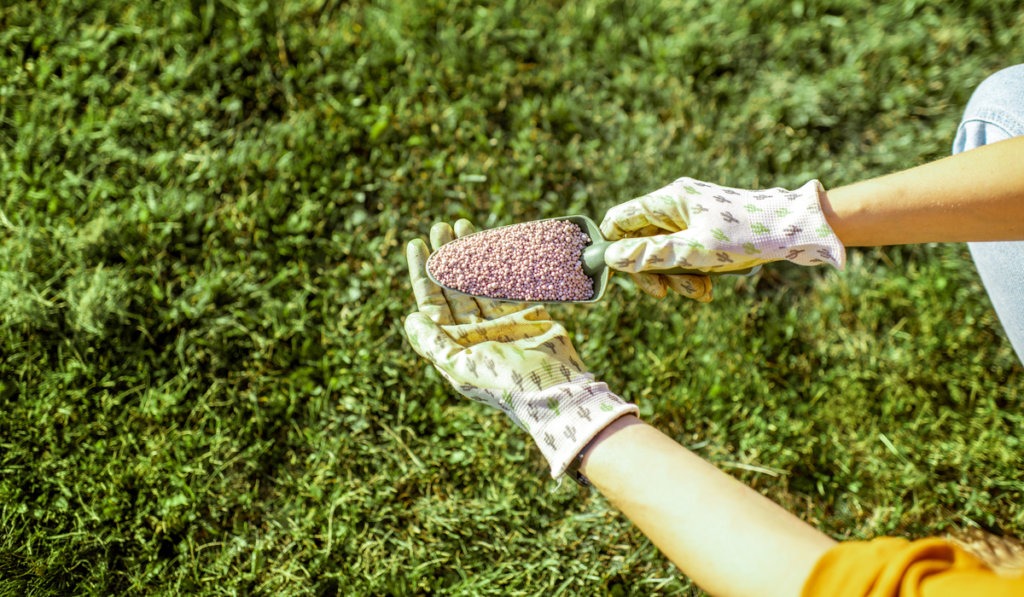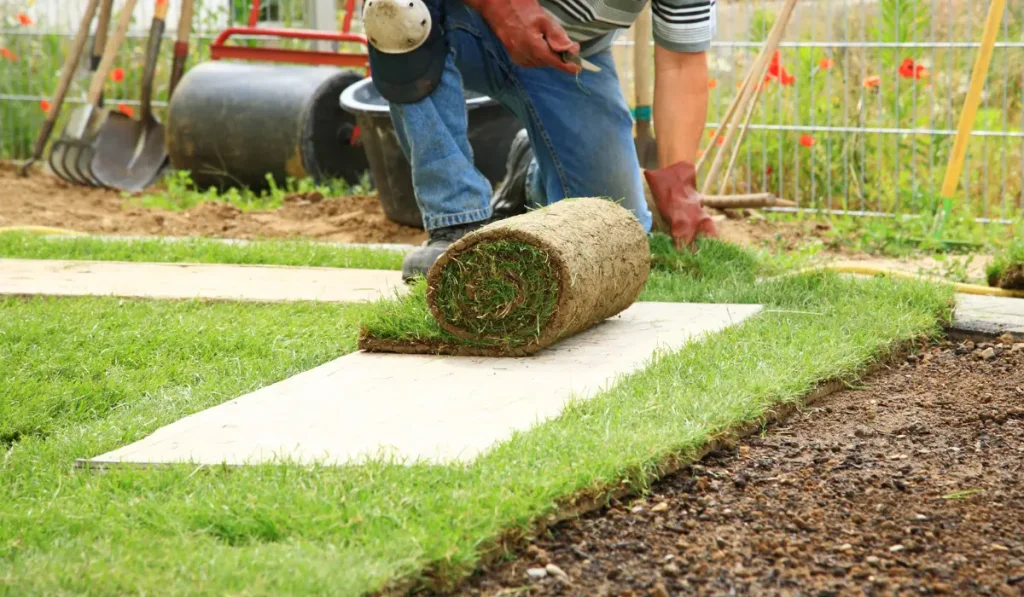Drought conditions can be tough on lawns, especially in California, where water restrictions and dry spells are common. But with some strategic lawn care, you can maintain a healthy, drought-resistant lawn that stays green while conserving water.
Here are six practical steps to drought-proof your lawn and keep it thriving, even during the summer heat.
Key Takeaways
- Choosing drought-tolerant grass and adding native plants helps create a lawn that thrives with less water.
- Deep, infrequent watering and using an irrigation system can reduce water waste and encourage deeper roots.
- Taller mowing heights and sharp mower blades protect grass from stress and help retain moisture.
- Aerating compacted soil and mulching improve water absorption and keep the lawn healthy during droughts.

1. Choose the Right Lawn Grass Type
One of the most effective ways to make your lawn resilient is to select drought-tolerant grass. Warm-season grasses like Bermuda Grass, Zoysia grass, and buffalo grass are excellent choices for hot climates. These varieties have deeper roots and are designed to withstand dry weather.
If you live in cooler areas, opt for cool-season grasses like tall fescue. Its deep root system helps it access water far below the surface. You can also add some native plants to the mix. Because they’re naturally suited to the local climate, they need less water and care.
Pro Tip: If you’re starting from scratch, consider overseeding your lawn with a mix of drought-tolerant grass seed for better adaptability.
2. Optimize Your Watering Routine
Efficient watering practices are key to conserving water and promoting deep root growth. Instead of frequent shallow watering, water deeply but less often. This encourages roots to grow deeper into the soil, making your lawn more drought-resistant.
Here are some tips to maximize water efficiency while promoting deep-root growth:
- Aim to provide about 1 inch of water per week, adjusting for rainfall.
- Water in the early morning to reduce evaporation and ensure the soil absorbs the water before the heat of the day.
- Use an irrigation system like sprinklers to prevent runoff and direct water where needed most.
3. Adjust Your Mowing Practices
Your mowing routine can significantly impact your lawn’s ability to retain moisture. Adjusting your mowing height is particularly important in drought conditions. To help your lawn retain moisture during dry spells, fine-tune your mowing habits with these smart tips:
- Raise your mower blades: Taller grass provides shade for the soil, reducing evaporation and helping the lawn retain moisture. Aim for a height of 3-4 inches.
- Keep your mower blades sharp: Dull blades tear the grass, which can lead to drought stress and water loss.
- Leave some grass clippings on the lawn: They can act as natural mulch, reducing evaporation and returning nutrients to the soil.
4. Mulch and Reduce Thatch
Mulching is a simple and effective way to lock in moisture and protect your lawn from the elements. A layer of mulch around trees and garden beds can reduce evaporation and regulate soil temperature.
If your lawn has a thick layer of thatch (more than ½ inches), dethatch it. While a little thatch is beneficial, too much can prevent water from reaching the roots. Instead, use organic materials like shredded bark or grass clippings for mulching.
5. Aerate Your Lawn
Aerating your lawn improves water absorption and helps roots grow deeper. This is especially helpful during drought conditions when water penetration is limited.
Depending on your grass type, aerate your lawn in the spring or early fall. Remove small plugs of soil with a core aerator. This will allow water and nutrients to reach the root system more effectively.
6. Limit Foot Traffic and Protect Vulnerable Areas
High-traffic areas can take a toll on your lawn, but there are easy ways to protect those spots and keep a healthy lawn. Create pathways or designate specific areas for heavy use to minimize damage to the turfgrass.
Bonus Tip: Embrace Dormancy
During extended periods of drought, it’s natural for lawns to enter dormancy, turning brown to conserve energy. Dormant grass isn’t dead—it’s just resting until conditions improve. Water your lawn minimally (about ½ inch every 2-3 weeks) to keep the roots alive.
If you’re looking for expert advice or need help selecting the best grass seed for your area, contact us at SodLawn today.
Frequently Asked Questions
What’s the best grass for drought conditions?
Grasses like Bermudagrass, tall fescue, buffalo grass, and zoysia grass are great for drought-prone areas. Their deep roots help them find water below the surface, making them tough enough to handle dry spells.
How often should I water my lawn during a drought?
Water your lawn deeply but less often, about 1 inch per week. Early morning is the best time to water because it gives the soil time to absorb the moisture before the heat of the day causes evaporation.



